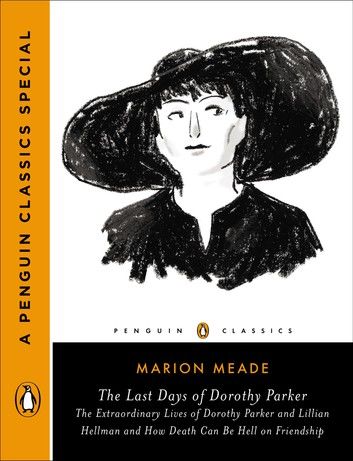| FindBook |
有 1 項符合
The Last Days of Dorothy Parker的圖書 |
 |
The Last Days of Dorothy Parker 作者:Marion Meade 出版社:Penguin Publishing Group 出版日期:2014-05-27 語言:英文 |
| 圖書館借閱 |
| 國家圖書館 | 全國圖書書目資訊網 | 國立公共資訊圖書館 | 電子書服務平台 | MetaCat 跨館整合查詢 |
| 臺北市立圖書館 | 新北市立圖書館 | 基隆市公共圖書館 | 桃園市立圖書館 | 新竹縣公共圖書館 |
| 苗栗縣立圖書館 | 臺中市立圖書館 | 彰化縣公共圖書館 | 南投縣文化局 | 雲林縣公共圖書館 |
| 嘉義縣圖書館 | 臺南市立圖書館 | 高雄市立圖書館 | 屏東縣公共圖書館 | 宜蘭縣公共圖書館 |
| 花蓮縣文化局 | 臺東縣文化處 |
|
|
Dorothy Parker biographer Marion Meade shares insight into the last days in the life of Dorothy Parker—the horrible and the hilarious—including her colorful friendship with Lillian Hellman, and the bizarre afterlife of Parker’s remains from a file cabinet on Wall Street to a small burial site by the NAACP office in Baltimore.
The Volney was a dignified residence hotel, favored by older women and their dogs, on Manhattan’s Upper East Side. Dorothy Parker died there, of a heart attack, on June 7, 1967. She was seventy-three and had been famous for almost half a century. As befitted a much-loved humorist, poet, and storywriter, the New York Times announced her exit in a front-page obituary. This was followed by a star-studded memorial service, also reported in the paper, which was attended by some 150 of her friends and admirers. More than twenty years later, on October 20, 1988, Parker was buried in Baltimore, in a memorial garden at the national headquarters of the NAACP. Why did it take more than two decades for Dorothy Parker to get a decent burial? What accounts for her macabre Edgar Allan Poe–style ending, arguably one of the most ghoulish in modern literary history? And just what happened to her during those twenty-one years?
Dorothy Parker biographer Marion Meade draws from new research to portray Parker in her last years and last days, with an emphasis on her posthumous existence. The story also features Parker’s enduring friendship of over thirty years with playwright and screenwriter Lillian Hellman, along with other notable figures in Parker’s circle, including Dashiell Hammett and John O’Hara. Always riotous and occasionally ghastly, The Last Days is utterly and completely Dorothy Parker.
|








